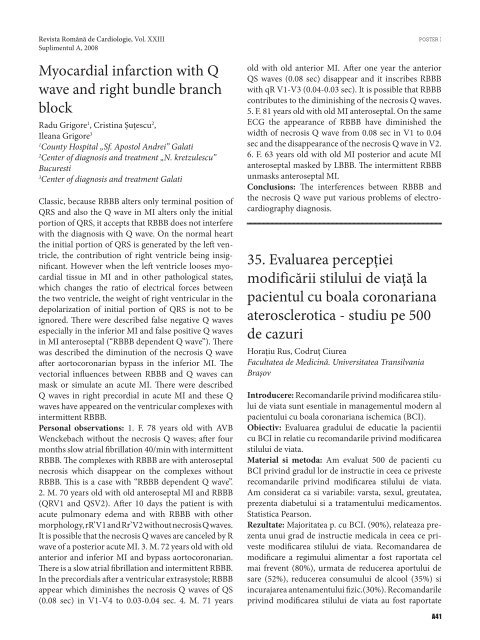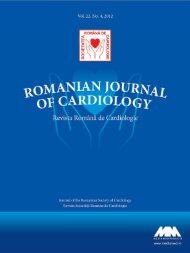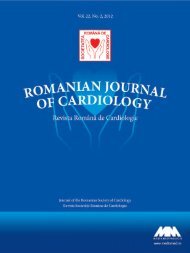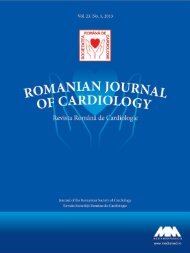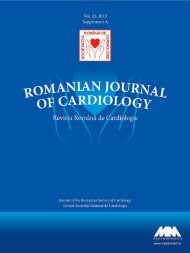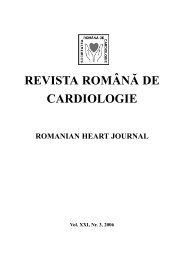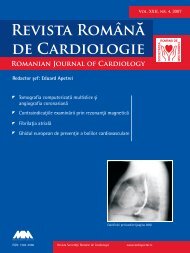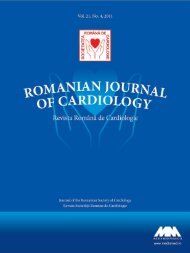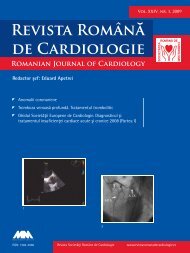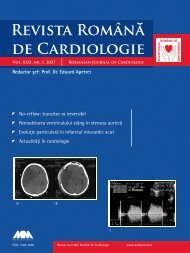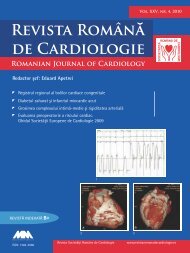Untitled - Romanian Journal of Cardiology
Untitled - Romanian Journal of Cardiology
Untitled - Romanian Journal of Cardiology
- No tags were found...
You also want an ePaper? Increase the reach of your titles
YUMPU automatically turns print PDFs into web optimized ePapers that Google loves.
Revista Română de Cardiologie, Vol. XXIII<br />
Suplimentul A, 2008<br />
Myocardial infarction with Q<br />
wave and right bundle branch<br />
block<br />
Radu Grigore 1 , Cristina Șuțescu 2 ,<br />
Ileana Grigore 3<br />
1<br />
County Hospital „Sf. Apostol Andrei” Galati<br />
2<br />
Center <strong>of</strong> diagnosis and treatment „N. kretzulescu”<br />
Bucuresti<br />
3<br />
Center <strong>of</strong> diagnosis and treatment Galati<br />
Classic, because RBBB alters only terminal position <strong>of</strong><br />
QRS and also the Q wave in MI alters only the initial<br />
portion <strong>of</strong> QRS, it accepts that RBBB does not interfere<br />
with the diagnosis with Q wave. On the normal heart<br />
the initial portion <strong>of</strong> QRS is generated by the left ventricle,<br />
the contribution <strong>of</strong> right ventricle being insi g-<br />
nificant. However when the left ventricle looses myocardial<br />
tissue in MI and in other pathological states,<br />
which changes the ratio <strong>of</strong> electrical forces between<br />
the two ventricle, the weight <strong>of</strong> right ventricular in the<br />
depolarization <strong>of</strong> initial portion <strong>of</strong> QRS is not to be<br />
ignored. There were described false negative Q waves<br />
especially in the inferior MI and false positive Q waves<br />
in MI anteroseptal (“RBBB dependent Q wave”). There<br />
was described the diminution <strong>of</strong> the necrosis Q wave<br />
after aortocoronarian bypass in the inferior MI. The<br />
vectorial influences between RBBB and Q waves can<br />
mask or simulate an acute MI. There were described<br />
Q waves in right precordial in acute MI and these Q<br />
waves have appeared on the ventricular complexes with<br />
intermittent RBBB.<br />
Personal observations: 1. F. 78 years old with AVB<br />
Wenckebach without the necrosis Q waves; after four<br />
months slow atrial fibrillation 40/min with intermittent<br />
RBBB. The complexes with RBBB are with anteroseptal<br />
necrosis which disappear on the complexes without<br />
RBBB. This is a case with “RBBB dependent Q wave”.<br />
2. M. 70 years old with old anteroseptal MI and RBBB<br />
(QRV1 and QSV2). After 10 days the patient is with<br />
acute pulmonary edema and with RBBB with other<br />
morphology, rR’V1 and Rr’V2 without necrosis Q waves.<br />
It is possible that the necrosis Q waves are canceled by R<br />
wave <strong>of</strong> a posterior acute MI. 3. M. 72 years old with old<br />
anterior and inferior MI and bypass aortocoronarian.<br />
There is a slow atrial fibrillation and intermittent RBBB.<br />
In the precordials after a ventricular extrasystole; RBBB<br />
appear which diminishes the necrosis Q waves <strong>of</strong> QS<br />
(0.08 sec) in V1-V4 to 0.03-0.04 sec. 4. M. 71 years<br />
POSTER I<br />
old with old anterior MI. After one year the anterior<br />
QS waves (0.08 sec) disappear and it inscribes RBBB<br />
with qR V1-V3 (0.04-0.03 sec). It is possible that RBBB<br />
contributes to the diminishing <strong>of</strong> the necrosis Q waves.<br />
5. F. 81 years old with old MI anteroseptal. On the same<br />
ECG the appearance <strong>of</strong> RBBB have diminished the<br />
width <strong>of</strong> necrosis Q wave from 0.08 sec in V1 to 0.04<br />
sec and the disappearance <strong>of</strong> the necrosis Q wave in V2.<br />
6. F. 63 years old with old MI posterior and acute MI<br />
anteroseptal masked by LBBB. The intermittent RBBB<br />
unmasks anteroseptal MI.<br />
Conclusions: The interferences between RBBB and<br />
the necrosis Q wave put various problems <strong>of</strong> electrocardiography<br />
diagnosis.<br />
35. Evaluarea percepţiei<br />
modificării stilului de viaţă la<br />
pacientul cu boala coronariana<br />
aterosclerotica - studiu pe 500<br />
de cazuri<br />
Horaţiu Rus, Codruţ Ciurea<br />
Facultatea de Medicină. Universitatea Transilvania<br />
Braşov<br />
Introducere: Recomandarile privind modificarea stilului<br />
de viata sunt esentiale in managementul modern al<br />
pacientului cu boala coronariana ischemica (BCI).<br />
Obiectiv: Evaluarea gradului de educatie la pacientii<br />
cu BCI in relatie cu recomandarile privind modificarea<br />
stilului de viata.<br />
Material si metoda: Am evaluat 500 de pacienti cu<br />
BCI privind gradul lor de instructie in ceea ce priveste<br />
recomandarile privind modificarea stilului de viata.<br />
Am considerat ca si variabile: varsta, sexul, greutatea,<br />
prezenta diabetului si a tratamentului medicamentos.<br />
Statistica Pearson.<br />
Rezultate: Majoritatea p. cu BCI. (90%), relateaza prezenta<br />
unui grad de instructie medicala in ceea ce priveste<br />
modificarea stilului de viata. Recomandarea de<br />
modificare a regimului alimentar a fost raportata cel<br />
mai frevent (80%), urmata de reducerea aportului de<br />
sare (52%), reducerea consumului de alcool (35%) si<br />
incu ra jarea antenamentului fizic.(30%). Recomandarile<br />
privind modificarea stilului de viata au fost raportate


